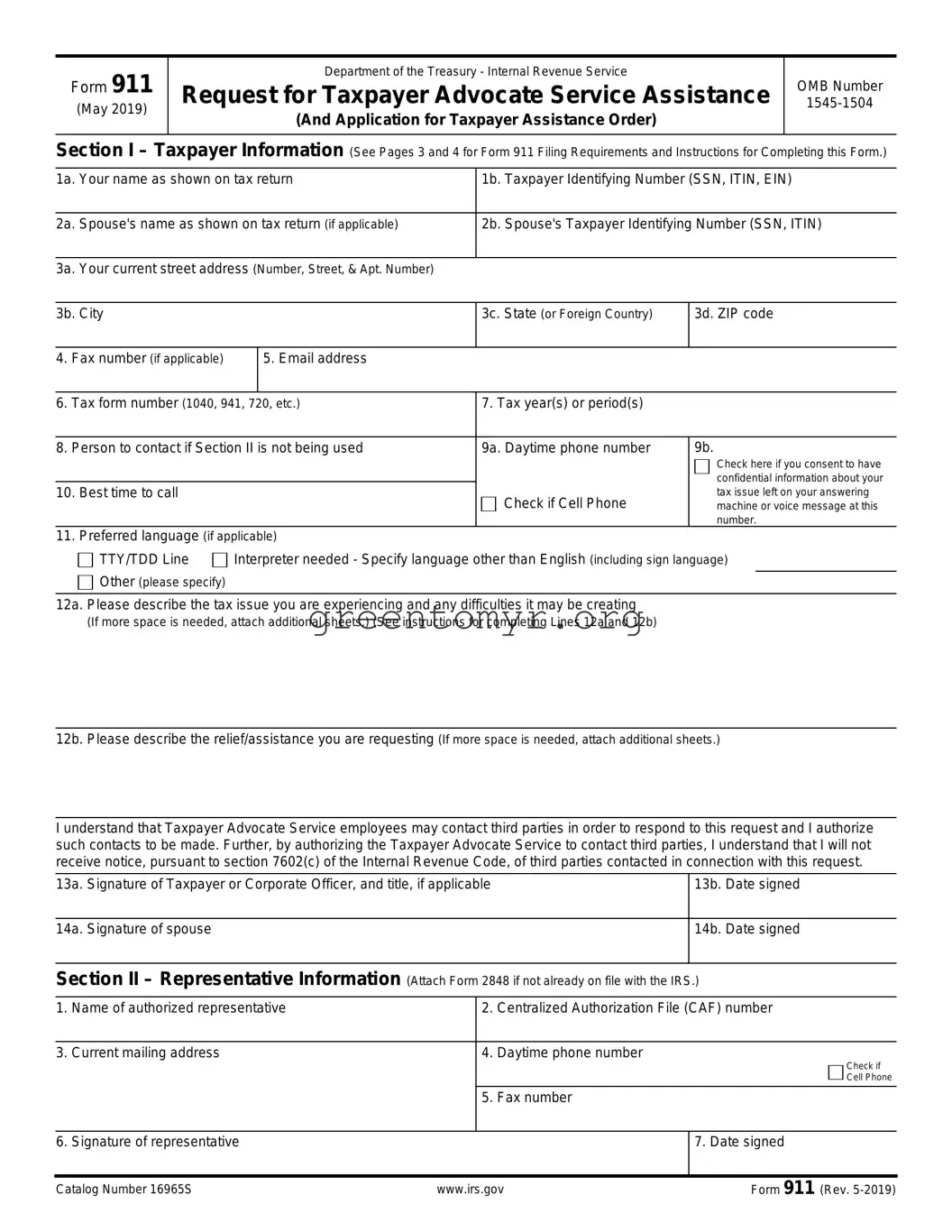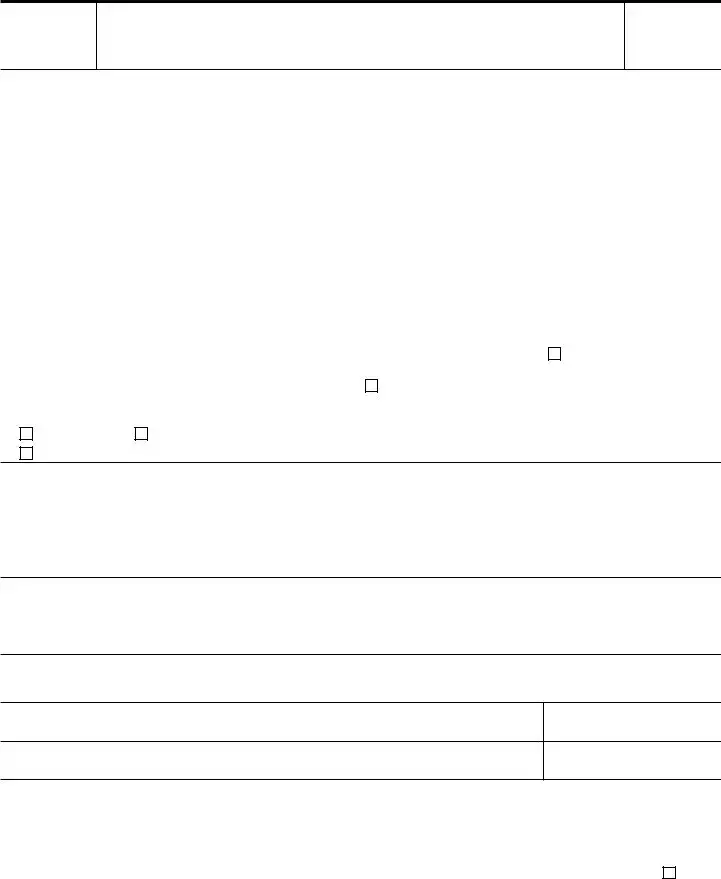Department of the Treasury - Internal Revenue Service
Request for Taxpayer Advocate Service Assistance
(And Application for Taxpayer Assistance Order)
Section I – Taxpayer Information (See Pages 3 and 4 for Form 911 Filing Requirements and Instructions for Completing this Form.)
1a. |
Your name as shown on tax return |
1b. Taxpayer Identifying Number (SSN, ITIN, EIN) |
|
|
|
|
|
|
2a. |
Spouse's name as shown on tax return (if applicable) |
2b. Spouse's Taxpayer Identifying Number (SSN, ITIN) |
|
|
|
|
|
|
3a. |
Your current street address (Number, Street, & Apt. Number) |
|
|
|
|
|
|
|
|
|
|
3b. |
City |
|
|
3c. State (or Foreign Country) |
3d. ZIP code |
|
|
|
|
|
|
4. Fax number (if applicable) |
|
5. Email address |
|
|
|
|
|
|
|
|
6. Tax form number (1040, 941, 720, etc.) |
7. Tax year(s) or period(s) |
|
|
|
|
|
|
8. Person to contact if Section II is not being used |
9a. Daytime phone number |
9b. |
|
|
|
|
|
Check here if you consent to have |
|
|
|
|
|
confidential information about your |
10. |
Best time to call |
|
|
Check if Cell Phone |
tax issue left on your answering |
|
|
|
|
machine or voice message at this |
|
|
|
|
|
number. |
11. |
Preferred language (if applicable) |
|
|
|
|
TTY/TDD Line |
Interpreter needed - Specify language other than English (including sign language) |
|
Other (please specify) |
|
|
|
|
|
|
|
|
|
|
|
12a. Please describe the tax issue you are experiencing and any difficulties it may be creating
(If more space is needed, attach additional sheets.) (See instructions for completing Lines 12a and 12b)
12b. Please describe the relief/assistance you are requesting (If more space is needed, attach additional sheets.)
I understand that Taxpayer Advocate Service employees may contact third parties in order to respond to this request and I authorize such contacts to be made. Further, by authorizing the Taxpayer Advocate Service to contact third parties, I understand that I will not receive notice, pursuant to section 7602(c) of the Internal Revenue Code, of third parties contacted in connection with this request.
13a. Signature of Taxpayer or Corporate Officer, and title, if applicable
Section II – Representative Information (Attach Form 2848 if not already on file with the IRS.)
1. |
Name of authorized representative |
|
2. |
Centralized Authorization File (CAF) number |
|
|
|
|
|
|
3. |
Current mailing address |
|
4. |
Daytime phone number |
Check if |
|
|
|
|
|
|
|
|
|
|
Cell Phone |
|
|
|
|
|
|
|
|
|
5. |
Fax number |
|
|
|
|
|
|
|
6. |
Signature of representative |
|
|
|
7. Date signed |
|
|
|
|
Catalog Number 16965S |
www.irs.gov |
Form 911 (Rev. 5-2019) |
|
|
|
|
|
|
Page 2 |
Section III – Initiating Employee Information (Section III is to be completed by the IRS only) |
|
|
|
|
|
|
Taxpayer name |
|
|
Taxpayer Identifying Number (TIN) |
|
|
|
|
|
|
|
1. |
Name of employee |
2. Phone number |
3a. Function |
3b. Operating division |
4. |
Organization code no. |
|
|
|
|
|
|
|
5. |
How identified and received (Check the appropriate box) |
|
6. |
IRS received date |
IRS Function identified issue as meeting Taxpayer Advocate Service (TAS) criteria

 (r) Functional referral (Function identified taxpayer issue as meeting TAS criteria)
(r) Functional referral (Function identified taxpayer issue as meeting TAS criteria)

 (x) Congressional correspondence/inquiry not addressed to TAS but referred for TAS handling
(x) Congressional correspondence/inquiry not addressed to TAS but referred for TAS handling
Name of Senator/Representative
Taxpayer or Representative requested TAS assistance

 (n) Taxpayer or representative called into a National Taxpayer Advocate (NTA) Toll-Free site
(n) Taxpayer or representative called into a National Taxpayer Advocate (NTA) Toll-Free site

 (s) Functional referral (taxpayer or representative specifically requested TAS assistance)
(s) Functional referral (taxpayer or representative specifically requested TAS assistance)
7.TAS criteria (Check the appropriate box. NOTE: Checkbox 9 is for TAS Use Only)

 (1) The taxpayer is experiencing economic harm or is about to suffer economic harm.
(1) The taxpayer is experiencing economic harm or is about to suffer economic harm.

 (2) The taxpayer is facing an immediate threat of adverse action.
(2) The taxpayer is facing an immediate threat of adverse action.

 (3) The taxpayer will incur significant costs if relief is not granted (including fees for professional representation).
(3) The taxpayer will incur significant costs if relief is not granted (including fees for professional representation).

 (4) The taxpayer will suffer irreparable injury or long-term adverse impact if relief is not granted.
(4) The taxpayer will suffer irreparable injury or long-term adverse impact if relief is not granted.
(if any items 1-4 are checked, complete Question 9 below)

 (5) The taxpayer has experienced a delay of more than 30 days to resolve a tax account problem.
(5) The taxpayer has experienced a delay of more than 30 days to resolve a tax account problem.

 (6) The taxpayer did not receive a response or resolution to their problem or inquiry by the date promised.
(6) The taxpayer did not receive a response or resolution to their problem or inquiry by the date promised.
(7)A system or procedure has either failed to operate as intended, or failed to resolve the taxpayer's problem or dispute within the IRS.
(8)The manner in which the tax laws are being administered raise considerations of equity, or have impaired or will impair the taxpayer's rights.

 (9) The NTA determines compelling public policy warrants assistance to an individual or group of taxpayers (TAS Use Only)
(9) The NTA determines compelling public policy warrants assistance to an individual or group of taxpayers (TAS Use Only)
8.What action(s) did you take to help resolve the issue? (This block MUST be completed by the initiating employee)
If you were unable to resolve the issue, state the reason why (if applicable)
9.Provide a description of the Taxpayer's situation, and where appropriate, explain the circumstances that are creating the economic burden and how the Taxpayer could be adversely affected if the requested assistance is not provided
(This block MUST be completed by the initiating employee)
10. How did the taxpayer learn about the Taxpayer Advocate Service |
|
|
IRS Forms or Publications |
Media |
IRS Employee |
Other (please specify) |
|
|
|
|
|
|
|
|
|
|
Catalog Number 16965S |
|
www.irs.gov |
|
Form 911 (Rev. 5-2019) |

Page 3
Instructions for completing Form 911
Form 911 Filing Requirements
The Taxpayer Advocate Service (TAS) is an independent organization within the IRS that helps taxpayers and protects taxpayer rights. We can help you resolve problems you can’t resolve with the IRS. And our service is free. TAS can help you if:
•Your problem is causing financial difficulty for you, your family, or your business.
•You face (or your business is facing) an immediate threat of adverse action.
•You’ve tried repeatedly to contact the IRS but no one has responded, or the IRS hasn’t responded by the date promised.
TAS will generally ask the IRS to stop certain activities while your request for assistance is pending (for example, lien filings, levies, and
seizures).
Where to Send this Form:
•The quickest method is Fax. TAS has at least one office in every state, the District of Columbia, and Puerto Rico. Submit this request to the TAS office in your state or city. You can find the fax number in the government listings in your local telephone directory, on our website at www.taxpayeradvocate.irs.gov, or in Publication 1546, Taxpayer Advocate Service - Your Voice at the IRS.
•You also can mail this form. You can find the mailing address and phone number (voice) of your local Taxpayer Advocate office in your phone book, on our website, and in Pub. 1546, or get this information by calling our toll-free number:
1-877-777-4778.
•Are you sending the form from overseas? Fax it to 1-855-818-5697 or mail it to: Taxpayer Advocate Service, Internal Revenue Service, PO Box 11996, San Juan, Puerto Rico 00922.
•Please be sure to fill out the form completely and submit it to the TAS office nearest you so we can work your issue as soon as possible.
What Happens Next?
If you don't hear from us within one week of submitting Form 911, please call the TAS office where you sent your request. You can find
the number at www.taxpayeradvocate.irs.gov.
Important Notes: Please be aware that by submitting this form, you are authorizing TAS to contact third parties as necessary to respond to your request, and you may not receive further notice about these contacts. For more information see IRC 7602(c).
Caution: TAS will not consider frivolous arguments raised on this form. You can find examples of frivolous arguments in Publication 2105, Why do I have to Pay Taxes? If you use this form to raise frivolous arguments, you may be subject to a penalty of $5,000.
Paperwork Reduction Act Notice: We ask for the information on this form to carry out the Internal Revenue laws of the United States. Your response is voluntary. You are not required to provide the information requested on a form that is subject to the Paperwork Reduction Act unless the form displays a valid OMB control number. Books or records relating to a form or its instructions must be retained as long as their contents may become material in the administration of any Internal Revenue law. Generally, tax returns and return information are confidential, as required by Code section 6103. Although the time needed to complete this form may vary depending on individual circumstances, the estimated average time is 30 minutes.
Should you have comments concerning the accuracy of this time estimate or suggestions for making this form simpler, please write to: Internal Revenue Service, Tax Products Coordinating Committee, Room 6406, 1111 Constitution Ave. NW, Washington, DC 20224.
Instructions for Section I
1a. Enter your name as shown on the tax return that relates to this request for assistance.
1b. Enter your Taxpayer Identifying Number. If you're an individual this will be either a Social Security Number (SSN) or Individual Taxpayer Identification Number (ITIN). If you're a business entity this will be your Employer Identification Number (EIN) (e.g. a
partnership, corporation, trust or self-employed individual with employees).
2a. Enter your spouse's name (if applicable) if this request relates to a jointly filed return.
2b. Enter your spouse's Taxpayer Identifying Number (SSN or ITIN) if this request relates to a jointly filed return.
3a-d. Enter your current mailing address, including street number and name, city, state, or foreign country, and zip code.
4.Enter your fax number, including the area code.
5.Enter your email address. We'll only contact you by email if we can't reach you by phone and your issue appears to be time- sensitive. We will not, however, use your email address to discuss the specifics of your case.
6.Enter the number of the Federal tax return or form that relates to this request. For example, an individual taxpayer with an income tax issue would enter Form 1040.
7.Enter the quarterly, annual, or other tax year or period that relates to this request. For example, if this request involves an income tax issue, enter the calendar or fiscal year, if an employment tax issue, enter the calendar quarter.
Instructions for Section I ► continue on the next page
Catalog Number 16965S |
www.irs.gov |
Form 911 (Rev. 5-2019) |
Page 4
Instructions for Section I - (Continued from Page 3)
8.Enter the name of the individual we should contact if Section II is not being used. For partnerships, corporations, trusts, etc., enter the name of the individual authorized to act on the entity's behalf. If the contact person is not the taxpayer or other authorized individual, please see the Instructions for Section II.
9a. Enter your daytime telephone number, including the area code. If this is a cell phone number, please check the box.
9b. If you have an answering machine or voice mail at this number and you consent to TAS leaving confidential information about your tax issue at this number, please check the box. You are not obligated to have information about your tax issue left at this number. If other individuals have access to the answering machine or the voice mail and you do not wish for them to receive any confidential information about your tax issue, please do not check the box.
10.Indicate the best time to call you. Please specify A.M. or P.M. hours.
11.Indicate any special communication needs (such as sign language). Specify any language other than English.
12a. Please describe the tax issue you are experiencing and any difficulties it may be creating. Specify the actions that the IRS has taken (or not taken) to resolve the issue. If the issue involves an IRS delay of more than 30 days in resolving your issue, indicate the date you first contacted the IRS for assistance. See Section III for a specific list of TAS criteria.
12b. Please describe the relief/assistance you are requesting. Specify the action you want taken and believe necessary to resolve the issue. Furnish any documentation you believe would assist us in resolving the issue.
13-14. If this is a joint assistance request, both spouses must sign and date the request. If only one spouse is requesting assistance, only that spouse must sign the request. If this request is being submitted for another individual, only a person authorized and empowered to act on that individual's behalf should sign the request. Requests for corporations must be signed by an officer and include the officer's title.
Note: The signing of this request allows the IRS by law to suspend any applicable statutory periods of limitation relating to the assessment or collection of taxes. However, it does not suspend any applicable periods for you to perform acts related to assessment or collection, such as petitioning the Tax Court for redetermination of a deficiency or requesting a Collection Due Process hearing.
Instructions for Section II
Taxpayers: If you wish to have a representative act on your behalf, you must give him/her power of attorney or tax information authorization for the tax return(s) and period(s) involved. For additional information see Form 2848, Power of Attorney and Declaration of Representative, or Form 8821, Tax Information Authorization, and the accompanying instructions.
Representatives: If you are an authorized representative submitting this request on behalf of the taxpayer identified in Section I, complete Blocks 1 through 7 of Section II. Attach a copy of Form 2848, Form 8821, or other power of attorney. Enter your Centralized Authorization File (CAF) number in Block 2 of Section II. The CAF number is the unique number that the IRS assigns to a representative after Form 2848 or Form 8821 is filed with an IRS office.
Note: Form 8821 does not authorize your appointee to advocate your position with respect to the Federal tax laws; to execute waivers, consents, or closing agreements; or to otherwise represent you before the IRS. Form 8821 does authorize anyone you designate to inspect and/or receive your confidential tax information in any office of the IRS, for the type of tax and tax periods you list on
Form 8821.
Instructions for Section III (For IRS Use Only) Please complete this section in its entirety.
Enter the taxpayer's name and taxpayer identification number from the first page of this form.
1.Enter your name.
2.Enter your phone number.
3a. Enter your Function (e.g., ACS, Collection, Examination, Customer Service, etc.).
3b. Enter your Operating Division (W&I, SB/SE, LB&I, or TE/GE).
4.Enter the Organization code number for your office (e.g., 18 for AUSC, 95 for Los Angeles).
5.Check the appropriate box that best reflects how the need for TAS assistance was identified. For example, did taxpayer or representative call or write to an IRS function or TAS.
6.Enter the date the taxpayer or representative called or visited an IRS office to request TAS assistance. Or enter the date when the IRS received the Congressional correspondence/inquiry or a written request for TAS assistance from the taxpayer or representative. If the IRS identified the taxpayer's issue as meeting TAS criteria, enter the date this determination was made.
7.Check the box that best describes the reason TAS assistance is requested. Box 9 is for TAS Use Only.
8.State the action(s) you took to help resolve the taxpayer's issue. State the reason(s) that prevented you from resolving the taxpayer's issue. For example, levy proceeds cannot be returned because they were already applied to a valid liability; an overpayment cannot be refunded because the statutory period for issuing a refund expired; or current law precludes a specific interest abatement.
9.Provide a description of the taxpayer's situation, and where appropriate, explain the circumstances that are creating the economic burden and how the taxpayer could be adversely affected if the requested assistance is not provided.
10.Ask the taxpayer how he or she learned about the TAS and indicate the response here.
Catalog Number 16965S |
www.irs.gov |
Form 911 (Rev. 5-2019) |






 (x) Congressional correspondence/inquiry not addressed to TAS but referred for TAS handling
(x) Congressional correspondence/inquiry not addressed to TAS but referred for TAS handling
 (n) Taxpayer or representative called into a National Taxpayer Advocate (NTA)
(n) Taxpayer or representative called into a National Taxpayer Advocate (NTA) 


 (1) The taxpayer is experiencing economic harm or is about to suffer economic harm.
(1) The taxpayer is experiencing economic harm or is about to suffer economic harm.
 (2) The taxpayer is facing an immediate threat of adverse action.
(2) The taxpayer is facing an immediate threat of adverse action.
 (3) The taxpayer will incur significant costs if relief is not granted (including fees for professional representation).
(3) The taxpayer will incur significant costs if relief is not granted (including fees for professional representation).
 (4) The taxpayer will suffer irreparable injury or
(4) The taxpayer will suffer irreparable injury or 
 (5) The taxpayer has experienced a delay of more than 30 days to resolve a tax account problem.
(5) The taxpayer has experienced a delay of more than 30 days to resolve a tax account problem.
 (6) The taxpayer did not receive a response or resolution to their problem or inquiry by the date promised.
(6) The taxpayer did not receive a response or resolution to their problem or inquiry by the date promised.
 (9) The NTA determines compelling public policy warrants assistance to an individual or group of taxpayers
(9) The NTA determines compelling public policy warrants assistance to an individual or group of taxpayers 
